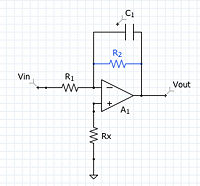Integrator Amplifier: Difference between revisions
| Line 13: | Line 13: | ||
"<math>R_{2}</math> ; Provides negative feedback for low output impedance needs. But it also distorts the output."<sup>1</sup> |
"<math>R_{2}</math> ; Provides negative feedback for low output impedance needs. But it also distorts the output."<sup>1</sup> |
||
The use of an Integrator circuit is the opposite of a Differentiator circuit. In other words, If you have a "^^^" style input and you Differentiate it you will get a "square sine wave" output. If you run the "square sine wave" as the input to an Integrator circuit you will end up with the "^^^" for the output. |
The use of an Integrator circuit is the opposite of a Differentiator circuit. In other words, If you have a "^^^" style input and you Differentiate it you will get a "square sine wave" output. If you run the "square sine wave" as the input to an Integrator circuit you will end up with the "^^^" for the output<sup>3</sup>. |
||
The Resistor (<math>R_{2}</math>) Is used to provide feedback<sup>2</sup> of the output DC voltage. Without this, circuit wouldn't perform as calculated because of the un-ideal conditions of real life. |
The Resistor (<math>R_{2}</math>) Is used to provide feedback<sup>2</sup> of the output DC voltage. Without this, circuit wouldn't perform as calculated because of the un-ideal conditions of real life. |
||
Revision as of 01:55, 11 January 2010
Amplifiers
Integrator
The circuit at right integrates the input voltage by using an Amplifier.
" ; Provides negative feedback for low output impedance needs. But it also distorts the output."1
The use of an Integrator circuit is the opposite of a Differentiator circuit. In other words, If you have a "^^^" style input and you Differentiate it you will get a "square sine wave" output. If you run the "square sine wave" as the input to an Integrator circuit you will end up with the "^^^" for the output3. The Resistor () Is used to provide feedback2 of the output DC voltage. Without this, circuit wouldn't perform as calculated because of the un-ideal conditions of real life.
Contributers
--Benjamin.henry 23:15, 10 January 2010 (UTC)
Readers
Sources
1 Quick Study "Electronics 1, Part 2"
3 Practical Electronics for Inventors (p545, 2nd edition)



